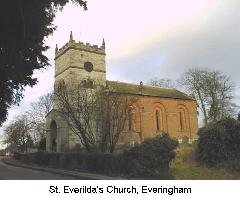| . |
The Everingham village is small, and stands amid beautiful scenery, five miles west of Market Weighton, and the same distance south of Pocklington. The name is said to be derived from St. Everildis, who established a religious house here about the middle of the seventh century. All traces of this convent have disappeared, and it's tradition has failed to preserve the memory of its site. Everild's sanctuary was called Everildsham. Another theory exists of Eofer, a boar, and also used as a personal name among the Anglo-Saxons. The descendants of Eofer were called Eofrings, and their clan settlement Eofringham, now Everingham.
Everingham Park is the seat of Lord Herries, Lord Lieutenant and Custos. Rotulorum of the East Riding. The mansion is a spacious structure of brick,with stone dressings, erected about a century ago. Attached to the mansion is a handsome Catholic church, dedicated to the Blessed Virgin and St. Everilda, erected in 1839 by the late Lord Herries. It is cruciform in plan, with an apsidal chancel at one end and an ante-chapel at the other. One transept forms the Lady Chapel and the other the sacristy. The church is lighted from the roof, which rests on Corinthian columns and pilasters, with an elegant entablature. Between the columns are statues and subjects in relief, representing the salient events in the life of our Lord; and standing on pedestals in various parts of the church are full length statues of the twelve apostles, the Blessed Virgin, St. Joseph, St. John the Baptist, and St. Everilda. The high altar is a magnificent piece of marblework. The font, curiously carved with birds and animals, supposed to be Saxon work, belonged originally to the parish church. The church was re-decorated at very considerable expense by the present noble owner in 1889. The park, covering 175 acres, is well wooded and stocked with deer. In the grounds is an artificial sheet of water, about eight acres in extent, which greatly enhances the beauty of the scenery.
|
 The church at Everingham Park, called by Torre, and other writers of the 17th and 18th centuries, St. Emeldis, but said to have been originally dedicated to St. Everilda, is a plain edifice in the Norman style, consisting of nave and chancel of brick, and a western tower of stone, containing three bells.
The church at Everingham Park, called by Torre, and other writers of the 17th and 18th centuries, St. Emeldis, but said to have been originally dedicated to St. Everilda, is a plain edifice in the Norman style, consisting of nave and chancel of brick, and a western tower of stone, containing three bells.